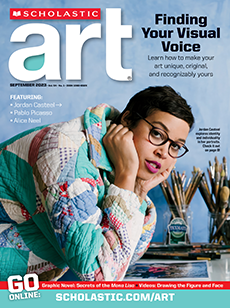What do you notice about the men in the paintings above and below? What are they wearing? What similarities or differences do you see in their poses? Painted by Jacques-Louis David around 1800, the work below shows Napoleon Bonaparte, the first Emperor of France. Kehinde Wiley painted the one above it in 2005. It is based on the David painting.
Kehinde Wiley: Portraits With Power
A contemporary artist reinvents portraiture, asking questions about power and status
Kehinde Wiley, Napoleon Leading the Army Over the Alps, 2005. Oil on canvas, 108 x 108 in. Brooklyn Museum, Collection of Suzi and Andrew B. Cohen, L2005.6. © Kehinde Wiley. Used by permission.
How does Wiley’s portrait, above, differ from the painting below? Why do you think Wiley made certain changes?
The Meaning of Power
Jacques Louis David (1748-1825), Bonaparte crossing the Great Saint Bernard Pass, 1801. Oil on canvas. Chateaux de Malmaison et Bois-Preau, Reuil-Malmaison, France. Credit: Erich Lessing / Art Resource, NY.
Both portraits show powerful men, but they explore different kinds of power. Hundreds of years ago, portraits in Europe were very expensive. To have one painted meant a person had financial power. As a result, the portraits we see in museums today often depict white, upper-class men.
Wiley re-creates historical paintings, replacing the original figures with black or Latino men. He chooses real people as models. The models may not have financial power, but they are physically powerful.
In Wiley’s version, the man wears construction boots, a symbol of physical work. The artist also uses light and shadow to draw attention to the figure’s toned muscles. At nine feet tall, the monumental painting dwarfs the viewer. As we look up at the man, Wiley challenges us to think about different kinds of power. He also asks us to question who has traditionally been left out of the world’s great art museums and why.
Street Casting
Wiley finds his models on the street in their own neighborhoods. He observes social groups and is drawn to natural leaders, inviting them to sit for his portraits. He calls this process “street casting.”
The artist works with the models to select historical portraits. The models wear their own clothing. Street casting allows Wiley to juxtapose the high status of those shown in traditional portraits with the everyday people he represents.
Emmanuel Eboué, 2010. Oil on canvas 72 x 60 in. © Kehinde Wiley. Used by permission.
How has Wiley emphasized the subject’s athletic power?
Playful Patterns
To celebrate the 2010 World Cup soccer tournament, the Puma shoe company asked Wiley to create a series of portraits featuring African soccer players. The portrait above shows Emmanuel Eboué, a player from Ivory Coast. The background is a vibrant repeat pattern in the complementary colors blue and orange. It is meant to evoke traditional African textiles. The pattern overlaps the figure’s torso in the foreground. It seems to move and change, contrasting with the athlete, who stares ahead with unmoving strength. What does this portrait say about Eboué?
“ So much of the body language in painting has to do with the communication of power.” —Kehinde Wiley
